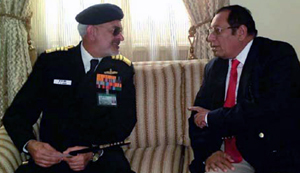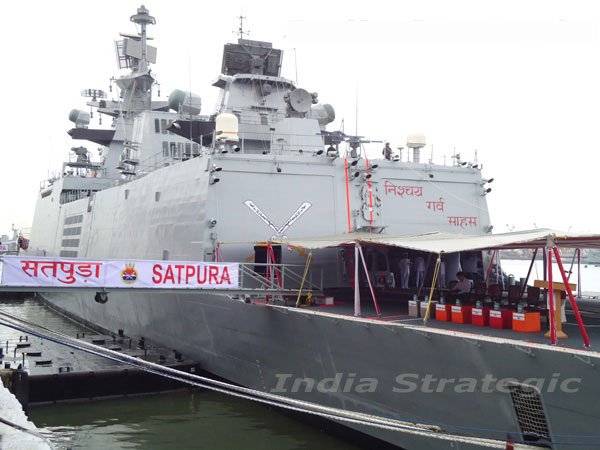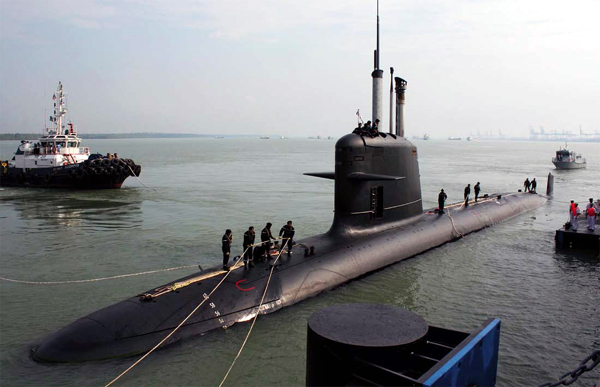|
The requirement has been pending for quite a
few years but the proposal for the new line, designated
Project 75-I, has now being given firm clearance
by the Government, according to Chief of the Naval
Staff Admiral DK Joshi.
 Asked
how soon is “very soon,” the naval Chief
told India
Strategic that the Defence Acquisition
Committee (DAC) had already cleared the Navy’s
note on Acceptance of Necessity (AON), the Navy
had finalized the RfP, and it was in its last
stage of formalities for clearance in the Ministry
of Defence. Asked
how soon is “very soon,” the naval Chief
told India
Strategic that the Defence Acquisition
Committee (DAC) had already cleared the Navy’s
note on Acceptance of Necessity (AON), the Navy
had finalized the RfP, and it was in its last
stage of formalities for clearance in the Ministry
of Defence.
As per the laid down procedures, depending on
the money involved, AON has to be cleared by a
competent authority. If the requirement involves
more than Rs 1000 crores (USD 200 million approx.),
then it is by the DAC, headed by the Defence Minister.
The approval was accorded just before the Indian
Navy Day on 4 December 2012.
AIP, or Air Independent Propulsion, increases
the mission life of a submarine by around three
times, depending upon the task and parameters
required. The capability enables a submarine to
generate air onboard without the need to surface
for breathing to recharge its batteries.
At present, none of the Indian submarines has
this capability, and some of them can only be
under water for three to five days. The existing
fleet of 14 diesel-electric submarines is rather
weak despite the periodic upgrades, although some
newer EW (Electronic Warfare) systems have been
installed. Submarines are about staying underwater
as long as possible, and that is why nuclear power
is used to keep them submerged for around three
months, or to the limits of human endurance.
The new Project 75-I submarines should be huge
in value, estimated at around USD 10 billion-plus
depending upon the offsets and ToT.
At present, six new Scorpenes under Project
75 are being built for more than USD 5 billion
(Rs 23,562 crore) by the state-run Mazagon Dock
Ltd. (MDL) under licence from the French DCNS
company.
MDL is also hoping to get the new Project 75-I
line but it has substantial work at hand for years,
14 ships in addition to the six Scorpenes. The
experience gained in building the Scorpenes though
should be extremely useful and must not get wasted.
AIP is also being considered for the last two
of the existing line of Scorpenes by installing
plugs – about eight meters in length and
the same diameter as that of the submarine. Admiral
Joshi said that DRDO was working on building these
plugs, but that if this entailed delay, “we
will not wait."
The Scorpene project is already late by three
years, with the first submarine is scheduled to
be out in June 2015 – instead of 2012 –
and the last in September 2018.

DCNS has offered to build the plugs and some
negotiations have taken place with it. Nonetheless,
(Defence Research and Development Organisation)
DRDO’s Naval Materials Research Laboratory
(NMRL) at Ambernath in Maharashtra is working
on the project to bring in some indigenous capability
and content.
About the Project 75-I, Ministry of Defence
(MoD) sources said that its Department of Defence
Production was working on fine-tuning some features
like Who-Will-Do-What among the Indian shipyards
and the suppliers in terms of sub-systems and
weapons. Details on offsets and Transfer of Technology
(ToT), which have a sizeable bearing on the costs,
are also being given the last touches.
Notably, the defence offsets policy mandates
a minimum investment of 30 per cent to be put
back in a related defence industrial venture in
India, but in the biggest defence contract that
is now being negotiated for the French Rafale
Multi Role Combat Aircraft (MRCA), this figure
is 50 per cent.
As per the indications however, the RfP for
the submarines should be out even in January 2013,
or by March latest before the financial year 2012-13
ends.
The Indian Navy's current fleet of conventional
diesel-electric submarines is quite old.
There are four HDW Shishumar class submarines
acquired from Germany and 10 Kilo Sindhughosh
class from Russia, both from 1986 onwards. The
service life of a submarine is estimated at around
20 years, but because of political indecision
after the allegations over the purchase of Bofors
guns from Sweden, the modernization process of
the Navy – along with that of the Army and
Indian Air Force – suffered.
In 1998, the then naval Chief Admiral Vishnu
Bhagwat projected a requirement for a 24-submarine
fleet in the Navy’s long-term vision for
30 years and in 1999, the Cabinet Committee of
Security (CCS) – the apex body headed by
the Prime Minister – actually approved the
plan for their indigenous construction in two
lines.
But the only direct submarine acquisition of
the Indian Navy after the old HDW and Kilo submarines
is that of the single nuclear power attack submarine
(SSN) INS Chakra from Russia in 2012. There are
also some technical issues with it, and during
his recent to New Delhi, Russian President Vladimir
Putin promsed to have them sorted out ASAP. An
SSN is a nuclear propelled but not nuclear armed
submarine.

The Scorpenes are being built in India to gain
experience and indigenous support capability.
India had gained some earlier with the induction
of HDW boats but as there was no follow-on programme,
that experience was lost and all those involved
in the project have retired.
Meanwhile, Admiral Joshi has said that India’s
indigenous nuclear-powered, nuclear-armed submarine
INS Chakra has successfully completed most of
the Harbour Acceptance Trials (HATs) and that
the boat will be ready for sea trials soon.
INS Chakra, an SSBN, meaning armed with nuclear
missiles, will complete India’s Land-Air-and-Sea
triad for nuclear deterrence when it is commissioned
in 2014. It will be armed with India-made nuclear
tipped missiles, some of which have already been
tested successully.
Pointing out that the Navy is giving attention
to the development of the submarines, Admiral
Joshi observed in his interview with India
Strategic:
"The Submarine arm once again has the opportunity
to operate SSNs along with our existing SSKs.
The modernisation of Shishumar and Sindhughosh
class submarines is a continuous process and is
progressing in a phased manner. Induction of Chakra
has provided us with a force multiplier. The trials
on Arihant have commenced and she will be joining
the submarine fleet shortly.
"Projects 75 and 75(I) are a part of the
Navy’s long term plan to achieve national
competence in submarine construction. The construction
of six state of the art Scorpene class submarines,
though slightly behind schedule, is now progressing
on a fast track at M/s MDL, Mumbai. We are also
in the final stages of formalising RFP for the
new Project 75 -I."
Admiral Joshi also said that the Navy's preferred
choice of inducting ships and submarines has been
through the indigenous route and of the 44 ships
and submarines presently on order, 42 are from
Indian shipyards, including private shipyards
and that over the next five years "we expect
to induct ships/submarines at an average rate
of 5-6 ships per year."
Significantly, the Navy will also be phasing
out about 3 vessels every year as part of the
modernisation process.
|